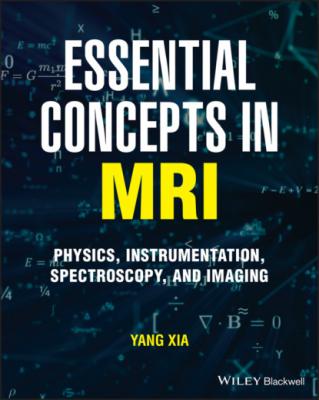Essential Concepts in MRI. Yang Xia
Читать онлайн.| Название | Essential Concepts in MRI |
|---|---|
| Автор произведения | Yang Xia |
| Жанр | Медицина |
| Серия | |
| Издательство | Медицина |
| Год выпуска | 0 |
| isbn | 9781119798248 |
In Chapter 2, the classical description of NMR, spin angular momentum is visualized as a spinning sphere that carries a charge (Figure 2.3b). In a quantum mechanical description of NMR, spin angular momentum is a quantum mechanical quantity without a classical analog; spin angular momentum is determined by the internal nuclear structure of the spin system. A classical limit is only approached in the case of orbital angular momentum and in the limit of large quantum numbers. Appendix 2 has some background introduction in quantum mechanics. This chapter presents the quantum mechanical description of the fundamental NMR concepts.
3.1 NUCLEAR MAGNETISM
A nuclear spin in quantum mechanical description is represented by a spin angular momentum operator I, which can be written in the usual Cartesian coordinate system as a dimensionless quantity
where Ix, Iy, and Iz are the spin operators representing the x, y, z components of the spin operator I.
The magnetic moment µ is proportional to its spin angular momentum,
where γ is a proportionality constant (called the gyromagnetic ratio), different for different nuclear species. This equation is identical to that in the classical description [Eq. (2.1)], except the spin I is now an operator.
A single nucleus in an external magnetic field (B0 = B0k) experiences the nuclear Zeeman interaction1 with the field. The evolution of a spin system ψ is governed by the time-dependent Schrödinger equation,
where ℋ is a Hamiltonian. (This equation plays a similar role as Eq. (2.3) in classical treatment of NMR in Chapter 2, where the Newton’s second law was used.) If ℋ is considered time-independent, the evolution of the spin system can be derived from the above equation as
where U(t) is the evolution operator. This equation effectively separates the time-independent part |ψ(t0)> from the time-dependent part U(t).
Since the Hamiltonian operator for the case of B0 = B0k is given by the Zeeman Hamiltonian, we can write down the operator ℋ as
Note that only the Iz component is present in the last part of Eq. (3.5), which is due to the properties of the dot product (cf. Appendix A1.1) since B0 = B0k.
As in the classical description where I is the spin angular momentum (a vector) and the half-integer or integer values of I are called spin quantum number I, the spin operator Iz has m possible values (the eigenvalues), ranging from −I, −I + 1, …, I, where m is the azimuthal quantum number.
Therefore, the evolution operator U(t) can be written as
where the second step considers the fact that ω0 = γB0 and θ = ω0t. U(t) is hence just a rotation operator [recall that exp(iθ) = cosθ + i sinθ, also in Appendix A1.1], which corresponds to a rotation of the spin state |ψ> about the z axis with an angular frequency ω0, known as the Larmor precession frequency:
This equation is identical to the equation that we have derived in the classical description [Eq. (2.5)].
3.2 ENERGY DIFFERENCE
From the energy eigenvalue equation,
one can obtain the energy eigenvalues of the Zeeman Hamiltonian ℋ, which are the energy levels (called the Zeeman levels):
Therefore, the energy difference ΔE between any two adjacent eigenstates of a spin system, known as the Zeeman splitting, is
As indicated in Eq. (3.9), a spin-1/2 system (I = 1/2) has only two eigenstates, corresponding to m = +1/2 (spin-up) and m = –1/2 (spin-down) states. Its two energy levels are therefore given by
Schematically, these two energy levels, which were shown once before briefly in Figure 2.2a, are now shown more completely in Figure 3.1. Note that for the spin-1/2 system, the “spin-up”
